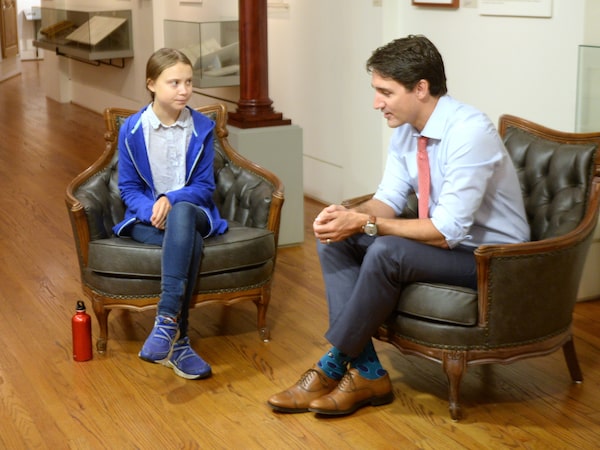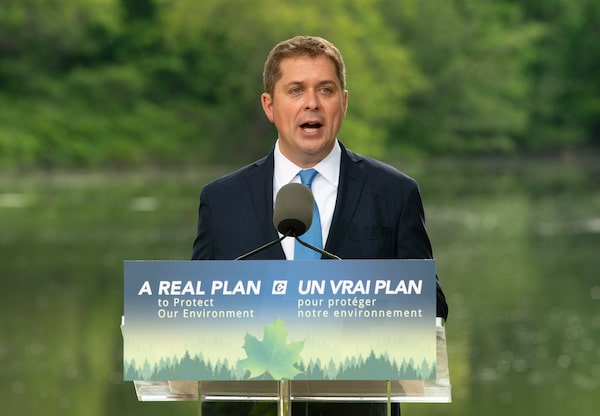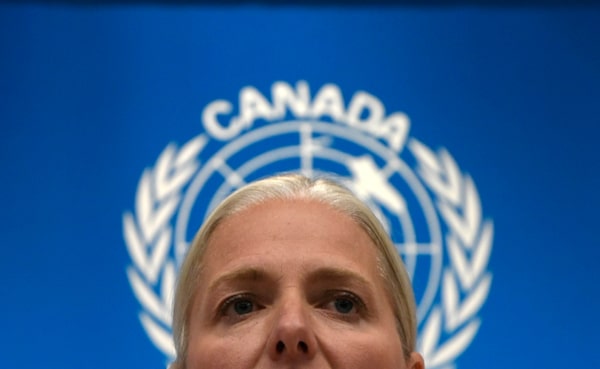Toronto, Sept. 27, 2019: Students from Lord Dufferin Public School gather at a climate protest as part of a day of action at cities across Canada.Christopher Katsarov/The Canadian Press
Gary Mason is a Globe and Mail columnist.
In May, 1985, British scientists made a shocking and deeply unsettling discovery: a massive hole in the ozone over Antarctica.
The ozone layer is the buffer vital to shielding humans from the potentially deadly effects of the sun’s rays. It was being ripped apart by the release of harmful chlorofluorocarbons into the atmosphere.
Chlorofluorocarbons come from a family of chemicals, widely used at the time, as coolants in refrigeration and air-conditioning units, among other things. Scientists began sounding warnings in the early 1970s about the danger they posed to the environment, alarms that were mostly ignored until the ozone hole made front-page news. Suddenly, politicians were confronted with a crisis situation: a world in which dangerous ultraviolet rays were no longer muted by the barrier that had been protecting us. Left unchecked, the radiation unleashed could lead to untold numbers of new health problems, including an epidemic of skin cancers.
The idea that a hole in the sky now exposed us to the merciless impact of the sun captured the public’s imagination in a way few other environmental crises ever had. People imagined humankind literally withering into extinction as crushing temperatures became unbearable. A genuine panic set in.
Two years after the ozone’s gaping wound was detected, leaders from around the world gathered in Canada to sign the landmark Montreal Protocol on Substances That Deplete the Ozone Layer. (It has now been ratified by 196 countries and the European Union). The treaty radically reduced the amount of these materials – commonly known as Freons – being released into the atmosphere. Among other achievements, the accord has, over three decades, reduced the use of nearly 100 ozone-draining chemicals by nearly 100 per cent. It has helped cut the equivalent of 135 billion tonnes of carbon-dioxide emissions. The ozone hole, meantime, has shrunk considerably and is now about the size it was in 1988. (It continued to grow years after it was first discovered).
NASA images show the Antarctic hole in the ozone layer from 1979 to 2010. The Montreal Protocol of the late 1980s stopped the hole's growth, and later reversed it, by keeping the chemicals causing ozone decay out of the atmosphere.NASA/The Associated Press
It was not by accident that Montreal became the setting of the historic agreement. Canada had taken a leadership role in the creation of the 1985 Vienna Convention, which was a precursor to the Protocol and the foundation upon which the Montreal pact would be built. Prime minister Brian Mulroney was more than happy to play host as he took the ozone threat seriously. He was also a great arm-twister and skilled negotiator. The team of officials representing Canada at the table included a young policy adviser by the name of Elizabeth May.
“The issues we faced then are similar to the issues we face now,” the federal Green Party Leader recalled during a break this week from the campaign trail. “If we had lost the ozone layer, all life on Earth was at risk and yet there were still people who were saying people just needed to wear sunscreen and broad-brimmed hats and they’d be okay.”
Canada’s role in the creation of one of the most powerful, and successful, environmental conventions ever undertaken is worth considering in the context of the federal election campaign and the current debate around climate change. This country was responsible for a mere fraction of the chemicals that had produced the hole in the ozone. But that didn’t stop us from playing a lead role in the creation of a manifesto that has done so much good for the world.
It’s also worth noting that the prime minister at the time was a staunch conservative, one who was also responsible for pushing Republican presidents Ronald Reagan and later George H.W. Bush on the issue of acid rain. His efforts would be rewarded in 1991 with an important treaty between the two countries that dealt with the issue. In fact, it can reasonably be argued that Mr. Mulroney did more for the environment than any other PM in our history.
Quebec City, 1985: Canadian prime minister Brian Mulroney holds talks with U.S. president Ronald Reagan. Mr. Mulroney was one of those pressing the Reagan administration to take the threat of acid rain more seriously.Scott Applewhite/The Associated Press

Montreal, 2019: Liberal leader Justin Trudeau speaks with Swedish climate activist Greta Thunberg ahead of the Sept. 27 climate strike. Afterward, she said Mr. Trudeau was 'obviously not doing enough' on climate change, but also stressed that she gave him the same message as other politicians and is focused on the big picture rather than any single leader's actions.Ryan Remiorz/The Canadian Press
How times have changed.
Today, we find ourselves at a disquieting juncture. After years of the environment and climate change being regarded as a marginal issue during federal election campaigns, this time was supposed to be different. Poll after poll had confirmed how concerned Canadians are about the grave threat a warming planet poses. The ground was set for a bold foray, a once-in-a-generation plan to meet the country’s obligations under the Paris accord and beyond. Even the Green Party seemed on the brink of a historic breakthrough, and the idea of sending 10 MPs or more to Ottawa was no longer just some tree-hugger’s fantasy. And yet here we are, more than a third of the way through the campaign, and there is nary a courageous, groundbreaking climate initiative in sight. Instead, the Liberals ended the week announcing measures to help make homes more energy efficient. While the time we have to mitigate the widespread damage a warming planet will cause evaporates before our eyes, we argue about the need for new pipelines. The debate around energy and the environment has become so caustic, so toxic, that our political leaders can’t even be honest with us.
There is no better example of this than when Liberal Leader Justin Trudeau said at a town hall event in Peterborough in January, 2017, that while he couldn’t shut down the oil sands immediately, “we need to phase them out, we need to manage the transition off of our dependence on fossil fuels.” It should not have been a controversial statement because it’s true. And yet, politicians in Alberta (and many citizens, too) lost their minds, accusing the Mr. Trudeau of betraying them, of forging a plan to rob thousands of people of their livelihoods. A few days later, Mr. Trudeau tried to undo the damage, saying that he “misspoke” – the oil sands would not be going anywhere soon, he assured Canadians.
Liberal Leader Justin Trudeau speaks at a 2017 town hall in Peterborough, Ont., where his remarks on the Canadian oilsands stirred controversy in Alberta.Adrian Wyld/The Canadian Press
I think that may have been the moment I decided meaningful climate policy in Canada was doomed. If a federal leader couldn’t even say what we know to be true – that we need to transition off of fossil fuels soon – then what hope was there of reducing greenhouse gas (GHG) emissions to the level we must, in the limited time we have?
As I look at the climate landscape in Canada, I see glimmers of hope, but also dark clouds of gloom and fear. Here are four central reasons for my pessimism.
First, neither of the two major parties with a realistic shot of leading the country after the Oct. 21 election has a strategy that will bring emissions down to the level they need to be. (Under the Paris accord, Canada has agreed to a 30-per-cent reduction of 2005 levels of GHGs by 2030). The Conservative “plan” has been rightly criticized by climate experts for being vague and more likely to drive GHG emissions up, than reduce them. The party hopes that new technology will solve the problem. In other words, the Conservatives have no real climate plan at all.

Conservative Leader Andrew Scheer announces his party's emissions policy in Chelsea, Que., this past June.Adrian Wyld/The Canadian Press
The Liberals deserve credit for bringing in the most meaningful measures to tackle climate change of any Canadian government to date. On Friday, Mr. Trudeau announced a $3-billion plan focused on “natural climate solutions” such as tree-planting. Earlier, this week, the party announced it is committed to achieving net-zero emissions by 2050 (which is the same as the Greens). It has promised to have legally binding five-year targets and will appoint an expert panel to advise on how to achieve the emission reductions required to meet the targets agreed to under the Paris accord.
This is all wonderful, but the thrust of their latest plan remains aspirational. Targets don’t reduce emissions by themselves; enforcement does. “Trust me” is not a climate policy.
Audits that have been conducted on the Liberals’ climate plan to date have suggested they are going to fall well short of their goals. Since the government introduced its first climate plan in 2016, it has purchased a pipeline and approved a massive liquefied natural gas project in B.C. It says it has put a cap on oil sands emissions of 100 megatonnes annually, but has refused to impose or insist on regulations to ensure that happens. There is also no schedule in place in which the cap begins to decline – a necessity.
By some estimates, at the current trajectory, emissions just from oil and gas production will be 80 per cent of Canada’s total emissions by 2050. Even by 2030, they are forecast to be 47 per cent off our total emissions output.
“We’d have to ban all fossil-fuel-car sales and stop all heating by gas in the country right now under that scenario and we’d probably still couldn’t meet our targets,” says Tzeporah Berman of Stand.earth, a grassroots environmental organization headquartered in San Francisco.
When it comes to meeting our Paris obligations, we are having a completely dishonest conversation.

Pro-pipeline demonstrators gathered in Calgary last November outside a venue where the finance minister was speaking.Jeff McIntosh/The Canadian Press
Second, there are fewer people today who believe anthropogenic climate change is a hoax, but a new form of denialism has taken its place, and it is no less insidious and dangerous. The “new climate denialism,” a term coined by Seth Klein and Shannon Daub of the Canadian Centre for Policy Alternatives, doesn’t dispute that the Earth has a problem with greenhouse gases. What the new deniers refuse to accept are the measures necessary to reverse the effects of climate change before it’s too late.
It’s not just members of the public who are in denial, but politicians and the oil and gas industry as well. Everyone agrees there is a problem, but few are willing to accept the sour medicine it will take to do something about it. So, for instance, you have an NDP government in B.C. It talks a wonderful game when it comes to climate, but then green-lights a $40-billion LNG expansion that will make meeting its climate targets all but impossible. A recent report by the province’s own Environment Ministry said that between 2007 and 2017, climate measures have been successful in reducing emissions by less than 1 per cent. In 10 years! Yet, you’d never know it from all the back-patting going on about carbon taxes and clean-fuel initiatives.
Industry is guilty of the same thing. Oil and gas companies all say they recognize climate change is real, that they are obligated to do something about it as good global citizens. But none is advocating the kind of action – such as ending opposition to tougher environmental impact assessments and methane regulations – that would help produce real change. It’s fake concern.

An oil worker holds raw sand bitumen near Fort McMurray, Alta.Jeff McIntosh/The Canadian Press
Third, there is another form of denialism going on that is also responsible for the lack of progress we’re witnessing around greenhouse-gas reduction: a refusal by oil and gas companies to acknowledge that their industry’s days are numbered. A recent piece in The New York Times by Christiana Figueres laid it out in stark detail. The life of many of the world’s oil and gas companies, in their current form, could be as little as five years in some cases, but no more than 30 even in the most optimistic scenarios, predicted Ms. Figueres, who was the executive secretary of the United Nations Framework Convention on Climate Change. Markets have started to abandon many of these companies. Exxon Mobil was the last big oil giant remaining in the top 10 of the world’s most valuable companies – until it dropped out earlier this month for the first time.
Ms. Figueres chronicled other moves that portend trouble for the industry. For instance, Norway’s massive sovereign wealth fund recently decided to get rid of nearly US$6-billion in oil and gas investments. The European Investment Bank, the world’s largest multilateral financier of climate-related investment, has proposed ending the underwriting of fossil-fuel infrastructure by 2020, including for gas. And the Danish pension fund is removing the top 10 major oil companies from its portfolio because their business models are incompatible with the Paris accord.
But you would never know any of this living in Canada. Here, talk of transitioning off oil, or the industry not having a bright future, is verboten in places such as Alberta and Saskatchewan. This denialism only serves to delay the implementation of measures critical to climate success.
It also ignores enticing analysis. Ten years ago, the British government commissioned a study into the transition to a low-carbon economy. Noted economist Nicholas Stern found, among other things, that every US$1 invested in a low-carbon economy now, saves a jurisdiction US$4 in 20 years.

Environment Minister Catherine McKenna speaks in Ottawa this past August.Adrian Wyld/The Canadian Press
Finally, it’s impossible to talk about inaction around climate change without mentioning the debilitating role inflammatory rhetoric now plays in the debate. We have heard how Environment Minister Catherine McKenna sometimes requires a security detail because of concerns about her safety. She tells the story of a time recently when she was walking outside a movie theatre with her three children and a car pulled up. The man inside rolled down the window and yelled a profanity Ms. McKenna’s way, before calling her “Climate Barbie,” a term of derision she has protested in the past for being sexist and demeaning.
Some of this is certainly the result of the times in which we live. Alberta Premier Jason Kenney, for one, has relied on often incendiary oratory to get supporters riled up against the Liberal government in Ottawa, which he blames for trying to kill the oil industry. (Even though it bought a pipeline.) But a phalanx of conservative premiers has railed against the dangers of climate measures that will “kill the economy.” The doubt these politicians have sowed in the minds of the public may be having an effect. A recent survey by the firm Ipsos found nearly half of those polled thought scientists were elitists whose findings they discounted because they don’t align with their personal beliefs. Other polls have shown that people believe climate change is real but don’t want to sacrifice much to reverse its effects – a result no doubt influenced by the words of politicians who have convinced many Canadians that measures such as a carbon tax are a mere money grab that will have no measurable impact on GHG emissions.
I wish I could be more optimistic about the future, about the will of Canadians to rise above the depressing lack of urgency that exists in this country to deal with the greatest threat the planet has ever faced. But at the moment, there doesn’t seem to be anything resembling the kind of mass anxiety necessary to produce the kind of call to arms needed to incite real change.
Instead, we content ourselves with the actions of a 16-year-old girl from Sweden who speaks a truth that makes the powerful squirm. We watch videos of her speeches and urge our friends on social media to do the same. “What a hero!” we exclaim. And while it’s no doubt true, lauding Greta Thunberg doesn’t do us a damn bit of good. We can’t just listen to her words, we must also heed them.
On Sept. 23, Greta Thunberg delivered a searing speech at the United Nations Climate Action Summit in New York. Listen to it here.
Reuters
Keep your Opinions sharp and informed. Get the Opinion newsletter. Sign up today.
 Gary Mason
Gary Mason